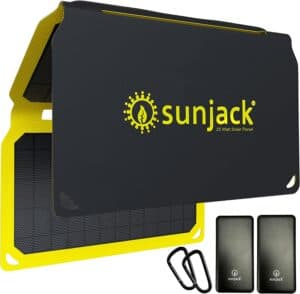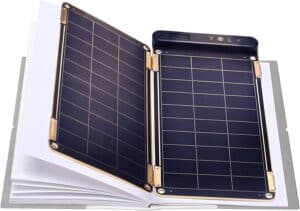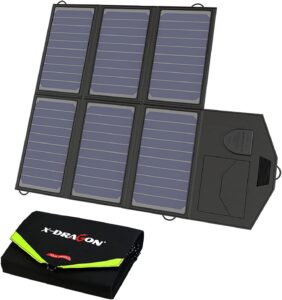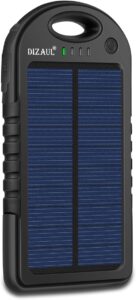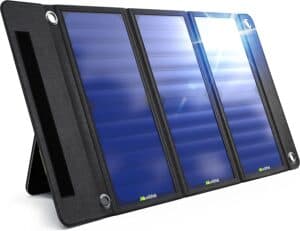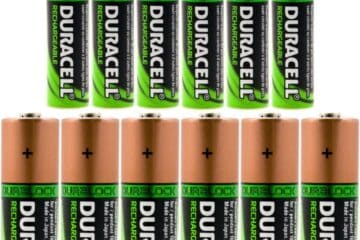Solar chargers are a useful alternative to traditional chargers because they don’t require the immediate availability of a wall outlet or car adapter. They are widely used for backcountry travel because of their ability to recharge while you’re spending your sunny day adventuring about in the wilderness.
Solar chargers are also far less resource-intensive than other charging methods. If you need to keep your phone, Kindle, or photography equipment powered up on your next multi-day journey into the backcountry, a solar charger is an essential purchase.
Making a decision on just one, however, can be difficult. That’s why we’ve created our list of the 10 Best Solar Chargers to help you narrow down your choices. Also, be sure to read on to our Buyer’s Guide and Frequently Asked Questions to learn everything you need to know to choose the perfect solar charger for your needs.
1. Goal Zero Guide 10

The perfect solar charger for backpackers, the Goal Zero Guide 10 will keep your phone juiced and ready to go to take the perfect photos on the trail. It will also keep your tablet powered up to 25 percent longer and includes AA rechargeable batteries.
This solar charger is also small and compact enough to carry with you wherever you go and can power up anywhere to give your device a much-needed boost. You’ll also love this solar charger at night because it includes a built-in LED flashlight that’ll help you find those small items in the depths of your dark backpack.
2. Anker 21W 2-Port Solar Charger

If you’re looking for limitless, off-the-grid power, the Anker 2-Port solar charger is another incredible option. Anker’s exclusive PowerIQ technology discovers and replicates your device’s original charging protocol so that it can deliver the fastest possible charging speed up to 2.4A per port of 3A overall in direct sunlight.
This solar charger features a compact design with dimensions of 11.1 x 6.3 inches when folded and 26.4 x 11.1 inches when opened. It also boasts stainless steel eyeholes on each corner for secure attachment to a backpack or tent. Finally, the Anker solar charger is crafted from industrial-strength PET plastic faced solar panels that are sewn into the high-wear polyester canvas so that it can withstand even the most rigorous of outdoor adventures.
3. SunJack 20W Solar Charger
Another solar charger that’s ideal for camping, backpacking, hiking, and other outdoor adventures, the SunJack is also an essential for any survival emergency preparedness kit. It’s weather-resistant folding solar panels easily fit inside any backpack to ensure that you’re never caught without power.
This solar charger folds down to the size of an iPad and is shock-proof, dustproof, drop-proof, and tested and used by the US Military. Its solar panels produce up to 2A per port to provide wall-outlet charging speeds. It also features a built-in smart IC chip that identifies your device to maximize charging speed and protect from overcharging.
4. YOLK Solar Paper
Possibly the most easily concealed solar charger available today, the YOLK Solar Paper is just one-third of the weight and one-eighth of the volume of its competitors. It also allows for the addition of extra solar panels when you need to charge larger devices, which makes it great for anyone looking for a solar charger with supreme adaptability.
This solar charger features a faster charging time capable of fully charging an iPhone 6 in just 2.5 hours by employing the most efficient solar panels available on the consumer market. It also offers auto-reset technology that eliminates the need to unplug and re-plug the cable every time a cloud passes overhead or you walk through a shadow.
5. X-DRAGON 40W Solar Charger
The X-Dragon’s PET solar panels are made with rugged, high-wear Oxford fabric to offer weather-resistant durability for any outdoor environment or activity. The charger’s surge protection, short circuit protection, and other advanced safety protections also keep you and your devices safe.
The X-Dragon 40W solar charger is built with US SunPower solar cells, which are roughly 50% more efficient than more common panels. It also features exclusive SolarIQ technology with a built-in smart IC chip that automatically adjusts the current and voltage to achieve maximum power and deliver up to 2.8A under direct sunlight.
6. Voltaic Systems 10W Rapid Solar Charger
Designed to power and charge laptops, professional cameras, and thousands of other consumer devices, the Voltaic Systems rapid solar charger is compatible with DSLR cameras from manufacturers like Sony, Asus, Acer, HP, Nikon, Canon, and Lenovo. It’s also compatible with Apple and Samsung smartphones.
This solar charger can store enough energy to power devices even when it’s cloudy and can deliver a full charge to most laptops in 6 hours and most smartphones in just one hour. It also features a total weight of just 3.6 pounds and a universal attachment system to connect to backpacks, bicycles, or wherever it’s needed.
7. Dizaul Solar Charger
Another water-resistant and shockproof solar charger, the Dizaul is made of eco-friendly silicone rubber and ABS + PC material (1). It is finished with a rubber paint surface and football grain design that provides an anti-skid protecting effect.
This solar charger boasts USB Ports protected by rubber caps to ensure they remain safe from water and dust so that they can sufficiently charge your smartphone, tablet, or other 5V USB-charged devices. It also features a free hook that allows for easy hanging on a backpack for long flights, in a car on your next road trip, or in your tent on your next camping excursion.
8. JETSUN Solar Charger
The JETSUN solar charger’s manufacturers had outdoor campers in mind when they designed it to be wear-resistant, shockproof, and dustproof. It also boasts a metal hook for hands-free use and the ability to hang it from your backpack while you’re exploring.
This solar charger offers dual output USB ports that transmit power to two devices simultaneously. It also features a 16,750mAh power bank, two built-in LED torches to light camp at night, and four LED indicator lights to help you keep track of battery level at all times.
9. Wildtek SOURCE
Designed for the extreme outdoor adventurer, the Wildtek SOURCE is the industry’s first fully waterproof and dustproof solar charger when stowed. It is also extremely efficient while utilizing a more compact solar panel to harness the sun’s energy. SunPower’s latest high-efficiency solar cells are nearly twice as efficient as competing chargers.
This solar charger uses SmartCharge Technology to detect the optimal charge for your USB powered device and is compatible with the iPhone 7, iPad Pro, Galaxy S8, and many others. It’s also extremely lightweight, portable, and includes a built-in stand so that you can set it up to receive optimal sun exposure when you’re not on the move.
Buyer’s Guide
While scientists have been working with the photovoltaic effect since the early 1800s, scientists at the U.S. Department of Energy’s National Renewable Energy Laboratory (NREL) (2) just set a world record in solar cell efficiency in 2008. That cell was capable of converting 40.8% of the light that hits it into electricity (3).
Today’s solar chargers are more efficient than ever, and we anticipate even more advances in the coming years. But that doesn’t make today’s buying decisions any easier, so to simplify things for you, this Buyer’s Guide will focus on wattage and output power, ease of use, and weight.
Wattage and Output Power
When buying a solar charger, wattage and output power are arguably the two most important factors to consider. Watts and amps are the most common units to become familiar with when trying to understand the performance potential of any given solar charger.
In the simplest terms, amps represent the current and watts represent electrical power. To provide a practical example, a 4 or 5-watt solar panel will be sufficient for simpler cell phones and mp3 players. However, many of today’s cell phones can be extremely power hungry, requiring upwards of 7 watts to be fully charged in a time-efficient manner.
If you’re hoping to find a solar charger that can also power an iPad, or you have multiple devices that need to be charged at once, you’re going to want a charger with at least 15 watts of power. Also, be aware that many smaller models (which do tend to be less expensive) can take forever to recharge.
Ease of Use
As with most advanced electronics, effective use of a solar charger can be more complicated than leaving it out in the sun and then plugging in your devices. If you’re hiking with a solar panel on your backpack, there are many models that will stop charging when an object comes between it and direct sunlight. Many will not restart unless you unplug devices and then plug them back in.
This becomes extremely inefficient and troublesome when you hike all day with the expectation that your devices will be fully charged when you stop for the evening. We’ve found that what the industry coins “auto-reset technology” is an essential feature to any useful solar charger.
Weight
Any experienced backpacker knows that weight is all-important. Many of you may have spent hours weighing each and every item in your backpack and experimenting with the absolute reduction of your total weight down to only the essentials.
As with many other backpacking essentials, the weight of a solar charger is an important consideration. When comparing weights of various solar panels, the best advice we can give is to make sure you’re comparing “apples to apples.”
In other words, some manufacturers will list only the weight of the panels while others will list the total weight of the panels and its accessories. Making sure you know exactly how much weight a solar charger will add to your pack set up is key.
Frequently Asked Questions
We recognize that more information will help you make the most informed decision on the solar panel that’s right for you, but that the sheer number of choices can be overwhelming. Our list of Frequently Asked Questions will provide answers to some of the most important considerations when selecting and using a solar charger.
How do solar chargers work?
Solar chargers convert solar energy into electricity by way of an electrochemical process. The panel gathers energy and stores it to the charger’s internal battery. Stored energy can then be used to charge 5V DC, USB-compatible devices.
How do I maximize the performance of my solar charger?
The best way to optimize the performance of any solar charger is to place it outside in direct sunlight. This means that the charger’s panels are positioned towards the sun and it is why you see many home solar panels facing south. Clouds and shade will have a negative impact on charging performance.
How long does it take for a solar charger to fully charge in the sun?
This largely depends on the exact model of charger you’re working with, but most chargers will achieve a 50% charge in 2.5 hours when placed in direct sunlight. Unfortunately, power absorption slows down as the battery reaches the end of its charging cycle, so charging the remaining 50% tends to require more than an additional 2.5 hours.
How long will it take for my charger to charge my phone?
Again, this varies. You’ll have to know the size of your phone’s internal battery, however, charging time of most solar chargers corresponds closely to the charging time of standard wall chargers.
Can my charger gather energy from the sun while indoors?
While the short answer is yes, the power absorption ability of most solar chargers will be compromised by anything, including window glass, which stands between the charger’s solar panels and direct sunlight. Artificial light will only provide a very marginal amount of energy.
Is it possible to leave my charger outside for too long?
Most solar charger manufacturers recommend leaving the charger outdoors and in direct sunlight as much as possible. This maximizes the likelihood that the charger’s battery will be fully charged when you need it.
However, it is also important to make sure that air is able to move freely around the charger while it’s charging. It’s also recommended to remove the charger from environments where the air temperature exceeds 122 degrees Fahrenheit (50 degrees Celsius), such as on the dashboard of a vehicle.
Summary
Solar power is the most abundant energy source on Earth, and if you could harness just one hour of full sunlight you’d have enough energy to power the entire Earth for a full year (4)! As you search for the perfect solar panel, we hope that you’ve found these recommendations and tips useful.
